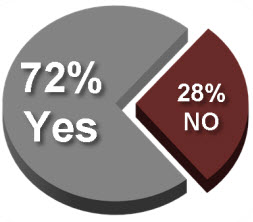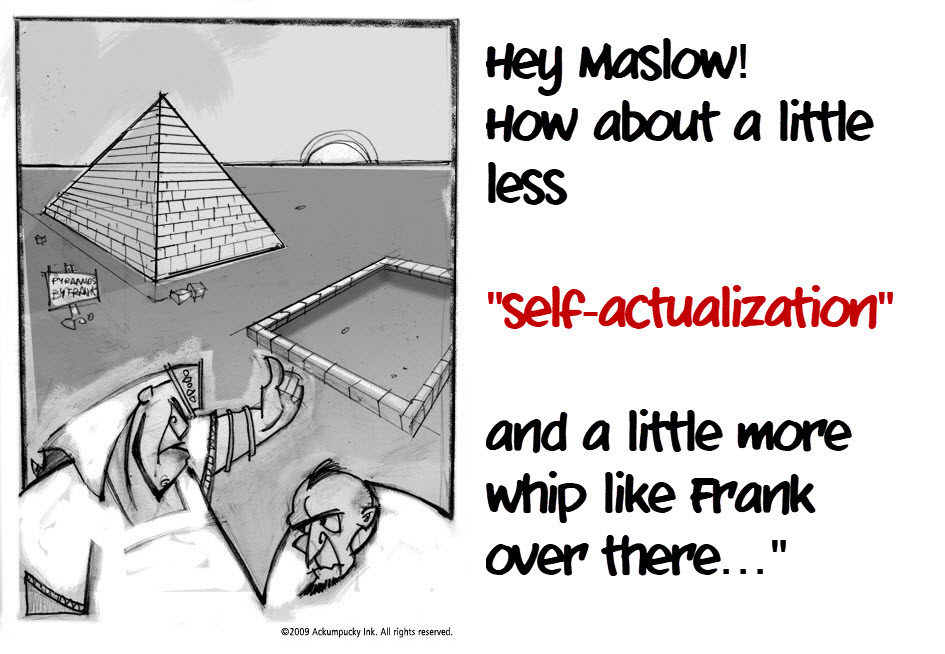A while back (like in 2009) I wrote what follows. This is edited a bit but by and large it is the same post (google seo be damned!)
Back then I ran a decidedly unscientific poll asking if Maslow’s Hierarchy of Needs was still a valid model for motivation. In other words, do people follow the hierarchy – and by extension, can you provide motivation by creating opportunities at each level for your employees, channel or customers?
My poll results from back then:
 72% said Maslow’s theory is a good model for motivation. 28% said it wasn’t.
72% said Maslow’s theory is a good model for motivation. 28% said it wasn’t.
Truthfully, I thought it would skew even higher on the “YES” side.
I’m not surprised that most thought Maslow was a good model considering that Maslow’s point of view has been in almost every marketing and management book since he came up with the idea in 1943. It is probably one of the most cited motivational models of all time.
Unfortunately – and I know a lot of you won’t like it – it’s BS.
Yep. It doesn’t apply today and more importantly – it has never been applicable.
Maslow has nothing to do with your motivation problems today.
Maslow Was Good – Just Not Perfect
Maslow’s theory isn’t bad, on the surface, tries to explain a lot, but it also leaves a lot on the table. To use one “theory” (and I put quotes around it because many who study these things don’t believe Maslow is a good foundational theory for motivation) to justify spending money on motivation isn’t good.
What Maslow Has is Stickiness
 If you haven’t read “Made To Stick” by the Heath brothers – now would be a good time. I think it accurately shows why Maslow’s Hierarchy has stuck with us for so long – even with its flaws.
If you haven’t read “Made To Stick” by the Heath brothers – now would be a good time. I think it accurately shows why Maslow’s Hierarchy has stuck with us for so long – even with its flaws.
The Heath brothers outlined six things an idea needs in order to stick: Simplicity, Unexpectedness, Concreteness, Credibility, Emotions, & Stories.
Let’s take a look at Maslow through this lens.
- Simple – what is simpler than the idea that we are motivated based on 5 things – very, very simple to understand.
- Unexpected – the unexpected part of this is that it is so simple. We expect humans to be complex but this theory makes it very simple – and that is unexpected.
- Concreteness – think pyramid – nothing is more concrete than a pyramid – heck they’ve been in Egypt for thousands of years – everyone knows how concrete that image is.
- Credibility – it comes from Maslow so it must be right!
- Emotions – the theory hits very close to home for many people – they can remember their first trophy or the first time they received public recognition – it resonates with them.
- Stories – it is very easy to tell the story of someone who is starving needing food and then needing shelter – and then needing recognition – the story builds on itself – creating the linkages that are familiar and easy to grasp.
Maslow’s Hierarchy fits this formula to a tee – and I suggest – one of the many reasons it has stayed in our heads and driven a lot of our motivation decisions for so many years.
But Maslow’s Theory has Some Big Big Holes
 Maslow’s theory has issues. And the issues should make you think twice about using it as the cornerstone for your motivation programs.
Maslow’s theory has issues. And the issues should make you think twice about using it as the cornerstone for your motivation programs.
The Issues:
It is a theory looking for data…
The theory has never, repeat, NEVER been proven empirically. Maslow himself said it was an idea he put out there for future study and analysis – but had no proof of his own. Maslow simply looked at a few people and said – “Here’s an idea – go see if it makes sense.”
In Maslow’s own words…
“’My fellow scientists can proceed with less passion, personal involvement, and heat—in the cool manner of science—to check whether I was right or not’
(Maslow’s Theory of Motivation and Hierarchy of Human Needs: A Critical Analysis, Allison Ruby Reid-Cunningham, MSW, School of Social Welfare – University of California – Berkeley)”
Once satisfied, lower level needs do not need further reinforcement…
According to Maslow, the lower level needs (those below Self Actualization) are called “D – Needs” or “deficiency needs.” These needs are only predominate when they are absent. Once fulfilled, they do not exert much, if any influence on our motivations. Therefore, once I’m clothed, I will not be motivated to get more clothes as much as I will be motivated for the next level of need. Only the top level need – “Self Actualization” is constantly driving behavior (but only after the lower levels are satisfied) and are called “B – Needs” or “being needs.” That level of motivation is “unsatisfiable” – or continues to drive behavior because it is focused on growth – the journey – not a specific destination or result like the lower level needs (hunger, thirst, etc.)
Also, the “D – Needs” gravitate toward stability. That is, we all try to get to a point of “homeostasis” at those levels. We’ll work (are motivated) to get to a point where we’re comfortable and balanced, neither too hungry nor too full, neither too hot or too cold. When we get to that point, that need is then met and we move on. Therefore, if your audience has a house, clothes, car, and all the other stuff we call “staples” they are less influenced than you think to earn awards – merchandise or any others. I’m not saying people aren’t motivated to earn awards – I’m saying they are less motivated once they hit that level of homeostasis.
And, according to Maslow, this applies all the way up to the fourth level – esteem needs. If I have a house, car, clothes, food, a loving family, a great group of friends and co-workers, a good job and regularly have someone comment on my work – I’m good to go.
No further intervention necessary – no additional survival, belonging or esteem juice make me more motivated.
We now flip the coin – Some say Lower Level Needs Are Never Satisfied…
The previous statement said that once satisfied, deficiency needs do not motivate as well. However, there are those in the scientific community that propose due to ever changing environments, we constantly bounce back and forth between needs. As my family changes, my needs change – as the economy changes, my needs change.
As an example, in today’s world many people who relied on commissions and bonuses to fund their lives will be sorely out of “homeostasis” now that their income dropped. They need to get back into balance. Cash and income are paramount to establishing their lower level of needs. I’ve seen posts that say because these people have reduced income they need more recognition (the next level up)! How would that work? Sorry you can’t make your mortgage but here’s a pat on the back. C’mon folks… this economy is pushing people lower on Maslow’s Hierarchy – not higher. I need to get some stability in the lower levels before I start worrying about social validation.
Don’t take my word for it…
I bounced this idea around with Dr. Nathan Bowling whom I used to connect with regularly on these things – he’s Professor of Psychology at Wright State University in Dayton, Ohio.
His comments back to me where pretty succinct:
“A few problems I see with it(Maslow’s Hierarchy):
- Data generally don’t support it
- Much of the theory may not be testable (e.g., what exactly is “self-actualization?”),
- Most workers (at least in the U.S.) have their biological and safety needs already satisfied, so a big part of the Maslow’s model isn’t all that relevant, and…
- People may actually focus their attention away from needs that are consistently left unsatisfied (this is a possibility that Maslow doesn’t allow for)
I typically spend a little time talking about Maslow’s theory in my undergrad industrial and organizational psychology course. I tell my students that it is a historically important theory, but that the vast majority of current researchers don’t accept it.”
So… Where does that leave us?
It leaves us here: There is no evidence the theory is correct.
We have conflicting points of view on the lower level needs – in one case we get satisfied and won’t be motivated by additional intervention at those levels – in the other case, we’re never satisfied and are constantly catching up – so we never get to the higher levels.
We have a PhD saying it really isn’t testable, nor relevant it today’s environment.
Net Net
There are a variety of theories about what motivates people, Vroom’s Expectancy Theory, McClelland’s Three-Need Theory, the Four-Drive Theory, and many others – all of them difficult to prove and even more difficult to disprove.
Here’s the bottom line – all these theories probably have some truth to them – and we should try to incorporate some of that thinking into our structures and strategies as we build initiatives to influence behavior.
But we can maybe finally agree that we should quit shouting Maslow from the rooftops! Please!





1 Pingback